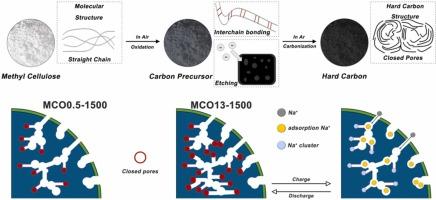Oxygen-bridging and air-etching: Advanced pore-regulation engineering in hard carbons for optimized low-voltage plateau capacity
IF 16.8
1区 材料科学
Q1 CHEMISTRY, PHYSICAL
引用次数: 0
Abstract
The intrinsic sodium storage performance of hard carbons is fundamentally governed by its structure attributes, which are primarily shaped by the precursor material. Therefore, a direct manipulation of precursors at the molecular level offers considerable flexibility in engineering hard carbon architectures. This study introduces a straightforward and effective pre-carbonization approach to modulate the molecular configuration and functional groups within celluloses, employing both oxygen-bridging and air-etching to stimulate the development of closed pores during carbonization. These closed pores not only facilitate the transport of sodium ions but also serve as active sites for sodium storage, resulting in a hard carbon with an impressive specific capacity of 421.1 mA h g−1 and a substantial low-voltage plateau capacity of 312.8 mA h g−1. Extensive research has elucidated the formation mechanism of closed pores as well as its correlation with low-voltage plateau capacity, which will greatly forward the rational design of high-performance hard carbon anodes for next-generation sodium ion batteries.

氧桥接和空气腐蚀:优化低压平台容量的硬碳先进孔隙调节工程
硬碳的固有储钠性能从根本上取决于其结构属性,而结构属性主要是由前驱体材料形成的。因此,在分子水平上直接操纵前体为工程硬碳结构提供了相当大的灵活性。本研究介绍了一种直接有效的预碳化方法来调节纤维素中的分子结构和官能团,采用氧桥接和空气蚀刻来刺激碳化过程中封闭孔的发展。这些封闭的孔隙不仅促进了钠离子的运输,而且还作为钠储存的活性位点,从而产生了具有421.1 mA h g-1的可观比容量和312.8 mA h g-1的低压平台容量的硬碳。广泛的研究已经阐明了封闭孔隙的形成机制及其与低压平台容量的关系,这将极大地推动下一代钠离子电池高性能硬碳阳极的合理设计。
本文章由计算机程序翻译,如有差异,请以英文原文为准。
求助全文
约1分钟内获得全文
求助全文
来源期刊

Nano Energy
CHEMISTRY, PHYSICAL-NANOSCIENCE & NANOTECHNOLOGY
CiteScore
30.30
自引率
7.40%
发文量
1207
审稿时长
23 days
期刊介绍:
Nano Energy is a multidisciplinary, rapid-publication forum of original peer-reviewed contributions on the science and engineering of nanomaterials and nanodevices used in all forms of energy harvesting, conversion, storage, utilization and policy. Through its mixture of articles, reviews, communications, research news, and information on key developments, Nano Energy provides a comprehensive coverage of this exciting and dynamic field which joins nanoscience and nanotechnology with energy science. The journal is relevant to all those who are interested in nanomaterials solutions to the energy problem.
Nano Energy publishes original experimental and theoretical research on all aspects of energy-related research which utilizes nanomaterials and nanotechnology. Manuscripts of four types are considered: review articles which inform readers of the latest research and advances in energy science; rapid communications which feature exciting research breakthroughs in the field; full-length articles which report comprehensive research developments; and news and opinions which comment on topical issues or express views on the developments in related fields.
 求助内容:
求助内容: 应助结果提醒方式:
应助结果提醒方式:


